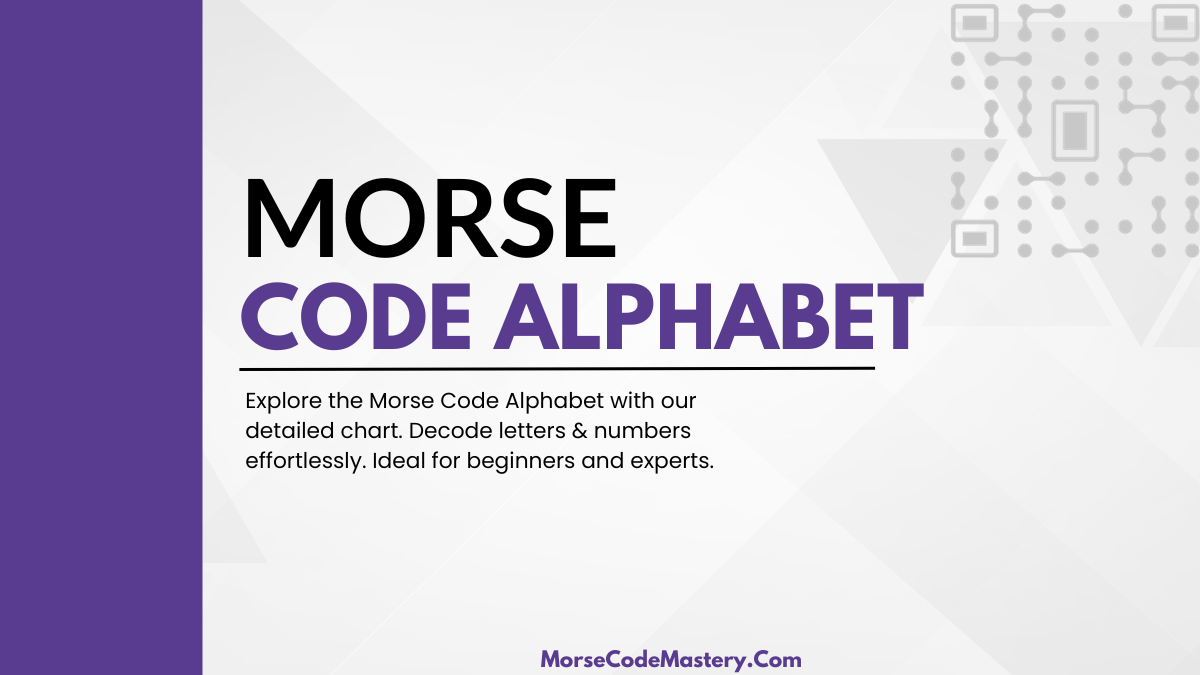Morse Code Alphabet: Comprehensive Chart & Guide

Morse code is an old but gold way of sending messages. Using just dots and dashes, it can spell out any message, big or small.
Before phones and computers, many relied on Morse code to chat across long distances. Today, even with all our new tech, it's still a special skill that holds value.
Table of Contents
Morse Code Alphabet Chart: Dots and Dashes Decoded
Each letter and number in Morse code has a unique pattern of dots (•) and dashes (—). Here's the Morse code for the letters A-Z and numbers 0-9 as per the International Morse Code:
| Letter/Number | Code |
|---|---|
| A | .- |
| B | -… |
| C | -.-. |
| D | -.. |
| E | . |
| F | ..-. |
| G | --. |
| H | …. |
| I | .. |
| J | .--- |
| K | -.- |
| L | .-.. |
| M | -- |
| N | -. |
| O | --- |
| P | .--. |
| Q | --.- |
| R | .-. |
| S | … |
| T | - |
| U | ..- |
| V | …- |
| W | .-- |
| X | -..- |
| Y | -.-- |
| Z | --.. |
| 0 | ----- |
| 1 | .---- |
| 2 | ..--- |
| 3 | …-- |
| 4 | ….- |
| 5 | ….. |
| 6 | -…. |
| 7 | --… |
| 8 | ---.. |
| 9 | ----. |
People around the world recognize and use this version as the standard for Morse code communication.
Military Morse Code Alphabet
The Military Morse Code is mostly for defense teams and is a lot like the International one. The standout thing about it? It has special shortcuts and signals just for military stuff.
These codes are great for quick messages, especially when there's no time to waste.
American Morse Code Alphabet
The American Morse Code, which began in the 1800s, is the U.S.'s first telegraph code. It differs from the international version because they tailored it to the needs back then.
While not widely used today, it's a significant part of the Morse code's history.
English Morse Code Alphabet
English Morse Code is almost the same as the International one. The small changes in it come from local ways of speaking and language details. This makes Morse code easy for English speakers everywhere.
Pronunciation and Tapping
Morse code isn't just about looking at dots and dashes; you also need to hear them. How they sound can change the meaning of the message.
Dahs and Dits:
People who use Morse code call the long sounds "dah" (for dashes) and the short sounds "dit" (for dots). At first, it might be hard to tell them apart. But if you keep listening and practicing, it gets easier. Remember, a "dah" is like three "dits" in length.
Tapping Method:
Some people don't just listen to Morse code; they tap it out. They use short and long touches, like dits and dahs, to send messages.
This way, you can "talk" in Morse without making any noise. It's good for times when you need to be quiet or if you're chatting with someone who can't hear very well.
Phonetic Alphabet:
When people talk over radios or phones, they use a phonetic alphabet to be super clear. Instead of just saying "A", they'll say "Alpha". Instead of "B", they'll say "Bravo".
This helps avoid mix-ups. Even though it's not Morse code, it's good to know if you're switching between talking and sending Morse code messages.
Tools and Resources
For those who are new to Morse code learning, having the right resources can be helpful. Here's what we offer:
Morse Code Alphabet Printable Chart
We've created a clear and high-resolution Morse code alphabet chart. Simply click here to view and save the image. You can easily print it out and keep it for reference.
Morse Code Translator
Want to convert text to Morse or vice versa? Our Morse Code Translator does just that. It's quick and easy to use. Try out the translator here for your Morse code needs.
Wrapping It Up
Morse code is a classic way of sending messages. People have used it for ages, from communicating on ships to sending vital military messages.
Even with all the new technology we have today, Morse code is still useful.
Learning Morse code is like learning a new language. It can be fun, and it's a great skill to have. And who knows? There might be a time when you'll be glad you know it.
Thank you for joining us on this quick journey through Morse code. Whether you're just curious or want to become an expert, we hope you found this guide helpful.